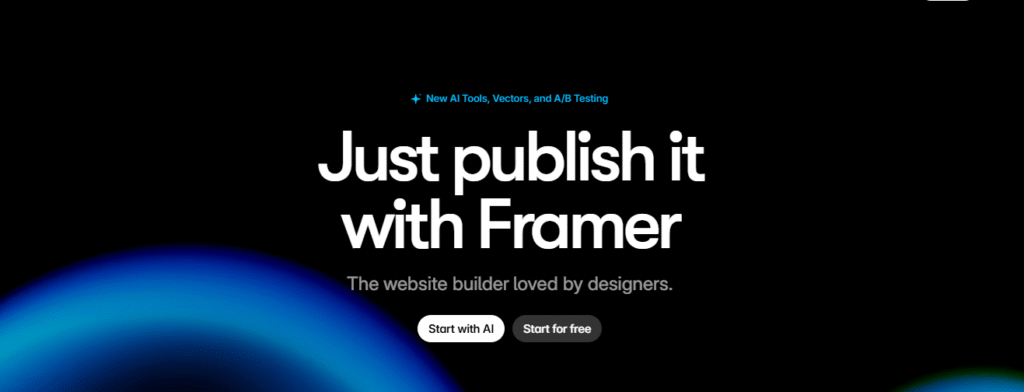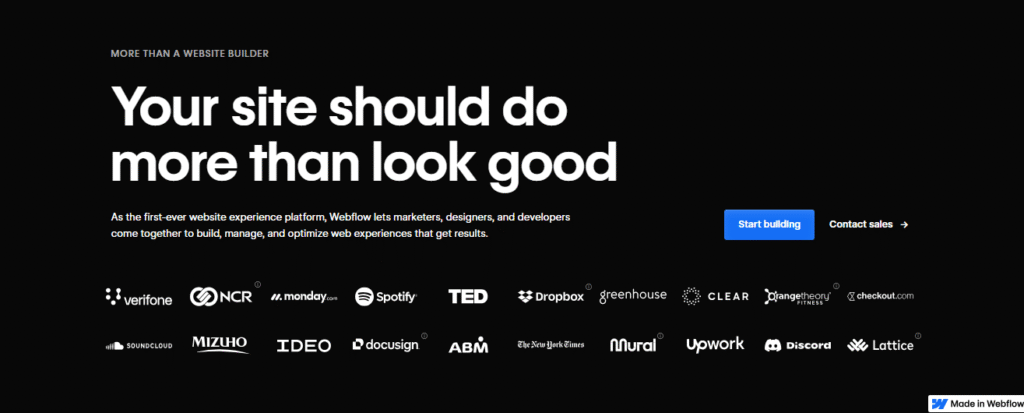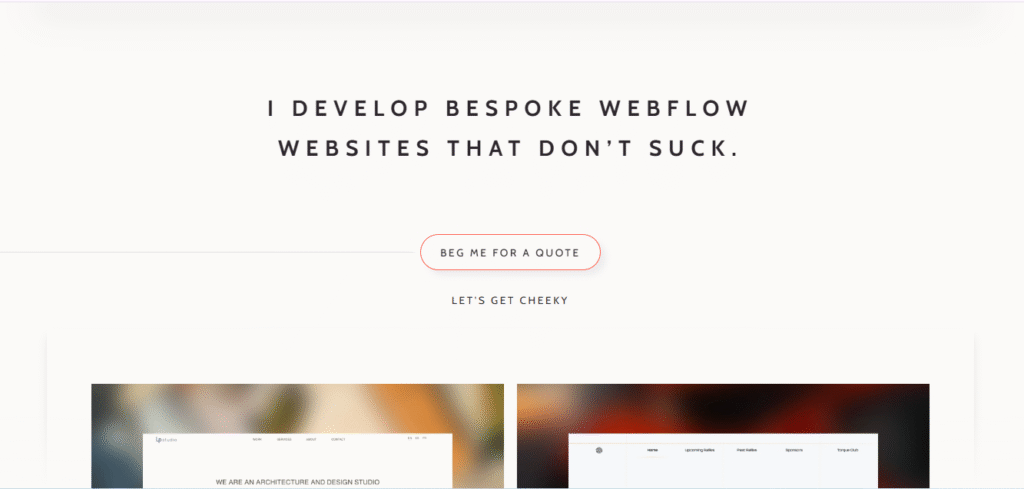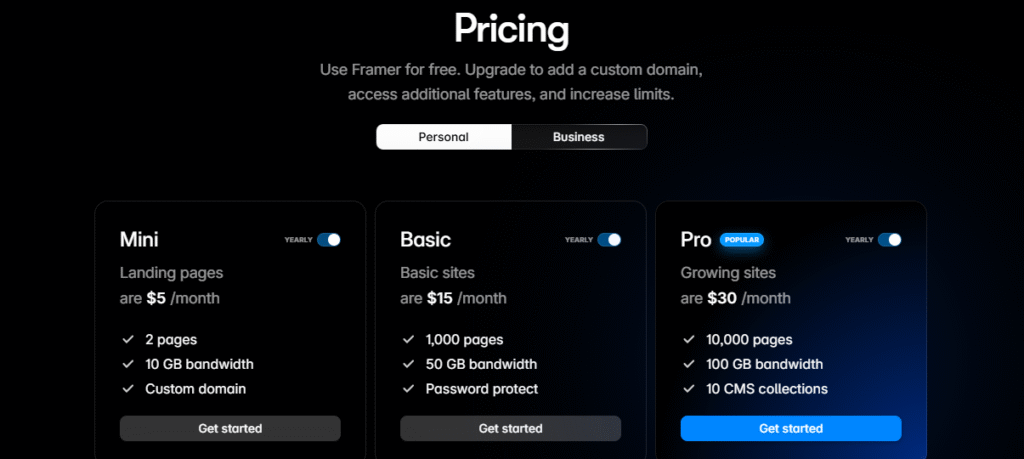By Abiola Gbolahan
Edited By Fredrick Oladipupo

Table of Contents
Framer vs Webflow – Best No-Code Builder for Designers in 2025
Which one truly gives designers full creative control—without writing code?
1. Introduction
In the world of modern web design, no-code tools are becoming the go-to choice for creatives who want full control without writing a single line of code. Among these, Framer and Webflow stand out as two of the most powerful options available today.
Both platforms offer pixel-perfect design flexibility, responsive layout controls, and powerful content management systems. But when it comes to choosing between them, your decision may depend on your workflow, experience level, and specific project needs.
This blog dives deep into the Framer vs Webflow 2025 debate to help designers, freelancers, and creative teams figure out which is the best no-code builder for designers. From real-world use cases to CMS breakdowns, consider this your go-to guide. Whether you’re searching for a Webflow alternative for designers, a detailed Framer website builder review, or wondering how Framer vs Webflow for freelancers compares. then you’re in the right place.
2. Platform Overview
2.1 Framer
Originally launched as a prototyping tool, Framer has rapidly evolved into a powerful website builder tailored for designers. With its fluid animations, modern UI, and intuitive, Figma-like experience, Framer makes it easy to turn static mockups into interactive, live websites fast.

The platform shines when building visually stunning landing pages and portfolios. Its real-time collaboration, built-in CMS, and drag-and-drop interface make it especially appealing for creatives who value speed without sacrificing style. If you’re looking for a sleek, responsive editor built with designers in mind, this Framer website builder review will show why it’s gaining momentum in 2025.
2.2 Webflow

Webflow, on the other hand, blends the power of web design and development into a no-code interface. It gives you deep control over layout, animations, and responsiveness mirroring what a front-end developer might do, but without writing a single line of code.
Unlike Framer, Webflow allows you to fine-tune everything from custom breakpoints to clean semantic HTML, making it a favorite for designers who want pixel-perfect control and dev-level flexibility.
If you’re comparing Framer vs Webflow for freelancers, Webflow may be better suited for complex projects, client work, or those who want to scale websites with more custom needs.
3. Design & Visual Control
When it comes to visual design, both Framer and Webflow give designers a powerful canvas but they approach it very differently.
3.1 Framer: Intuitive for Designers
Framer’s interface feels familiar if you’ve ever used Figma. It supports auto layout, flexbox, and CSS grid in a way that feels natural to visual thinkers. With drag-and-drop elements, smart guides, and live preview, it lets you focus more on creativity and less on technical details.
Animations are smooth and built right in and no need to dive into complex settings. For designers who want to build and ship beautiful landing pages quickly, this part of the Framer website builder review highlights why many creatives are making the switch.

The above image is a landing page of a website created with Framer. Check more on websites made with Framer here
Framer also uses global design tokens for consistent styling, making it a strong Webflow alternative for designers who prioritize visual storytelling over technical depth.
3.2 Webflow: Precision with a Learning Curve
Webflow gives you total control over your layout with a full CSS engine. From flexbox and grid to margin and padding tweaks, you’re basically doing front-end development without writing code. It’s powerful, but expect a steeper learning curve.
Animations are handled through an advanced timeline-based editor, which opens the door to detailed, custom interactions but also requires more setup time. below is a typical website made with webflow

Unlike Framer, Webflow’s UI is more development-oriented. It’s built for those who want pixel-perfect precision and don’t mind investing time to learn. If you’re comparing Framer vs Webflow for freelancers, Webflow might be the better fit for handling client requests with intricate design specs.
In terms of styling, Webflow leans on style classes and guides, offering design structure at scale.
4. Developer-Like Power (No-Code/Low-Code)
While both Framer and Webflow are no-code platforms, their approach to developer-level functionality is vastly different especially when you’re building more complex or scalable websites.
4.1 Webflow: Visual Power for Devs
Webflow bridges the gap between design and development better than almost any other platform. It allows full HTML, CSS, and JavaScript embedding, so designers can implement advanced features without switching platforms. You also get clean code export, making it a favorite for dev teams that want to prototype and then migrate.
With Webflow’s Logic (beta), you can create conditional flows like dynamic content filtering or simple automations without writing traditional scripts. Combined with the robust Webflow CMS, this gives freelancers and teams more control over dynamic websites.
In short, if you’re comparing Framer vs Webflow for freelancers or need API access and advanced logic, Webflow behaves more like a true visual development tool.
4.2 Framer: Design-First, Code-Lite
Framer, by contrast, is squarely focused on being a design-first tool. It supports basic JavaScript embeds, and the Framer CMS is easy to use for simple content-driven sites, but the developer features are intentionally limited.
Framer does not allow code export, nor does it support API integrations or complex logic flows at least not natively. This makes it ideal for fast, stunning websites, but less suited for those who want full control under the hood.
Still, many creatives choose Framer as a Webflow alternative for designers who prioritize speed, visuals, and simplicity over backend flexibility.
If you’re stuck between Framer CMS vs Webflow CMS, the choice comes down to complexity: Framer is easier to manage for personal sites or portfolios, while Webflow scales better for larger, structured content needs.
5. SEO & Performance – Feature Comparison
| SEO & Performance Feature | Framer | Webflow |
|---|---|---|
| Meta Tags / Open Graph | Simple setup via UI | Advanced SEO controls with full customization |
| Clean Code Output | Clean React-based code (not editable) | Fully structured HTML/CSS, exportable & clean |
| Sitemap / Robots.txt | Automatically generated | Full control and manual editing available |
| Page Speed Optimization | Built on React for fast rendering | Optimized, lightweight output |
6. Ideal Use Cases: Framer vs Webflow
Choosing between Framer vs Webflowoften comes down to what you’re building and who you’re building it for. While both are powerful no-code tools, they shine in different scenarios. Here’s a breakdown of where each platform excels:
| Use Case | Best Tool |
|---|---|
| Visual Portfolio Website | Framer |
| Complex Marketing Website | Webflow |
| Multi-language Websites | Both (via integrations) |
| Product Launch Landing Page | Framer |
| Developer Handoff / Export | Webflow |
| Freelance Agency Website | Webflow |
Okay, Let me Break it down for you to make the right choice when building:
- Framer is ideal for designers and startups who want to quickly spin up stunning visual portfolios or landing pages with smooth animations and a clean aesthetic. It feels like designing directly in Figma but goes live in minutes.
- Webflow, on the other hand, is perfect for more complex builds like multi-page marketing sites, custom interactions, or agency portfolios that need scalability and developer-level control. Features like full code export and advanced CMS logic make it a favorite for professional teams and freelancers.
- If you’re targeting global audiences, both platforms can support multi-language sites, though Webflow’s native integrations and third-party tools may offer slightly more robust support.
7. Learning Curve & Community
When it comes to ease of learning, Framer offers a gentler slope especially for designers who are already familiar with tools like Figma. Its drag-and-drop interface, intuitive layout controls, and modern visual editor make it easy to build stunning sites without a technical background. This simplicity, paired with its growing appeal among indie creators and design-focused entrepreneurs, has helped the Framer community expand rapidly in recent years.
On the other hand, Webflow is a powerhouse that gives users full control over their site’s structure and behavior but that power comes with a steeper learning curve. To fully leverage its capabilities, users need a good grasp of web fundamentals like HTML, CSS, and the box model. However, Webflow’s extensive educational hub, Webflow University, along with its large global community and robust freelance ecosystem, ensures that creators have plenty of resources and support to master the platform over time.
8. Pricing: Framer vs Webflow
When it comes to pricing, Framer and Webflow cater to different types of users with varying levels of needs whether you’re a solo creator, startup founder, or part of a growing design agency.
8.1 Framer Pricing

Framer’s pricing is simple and starts with a Free Plan (1 site with Framer branding). The $5/month Mini Plan suits basic landing pages with limited traffic, while the $15/month Basic Plan adds CMS, 1000 pages, and password protection which is great for personal or business sites. The $30/month Pro Plan scales up with analytics, redirects, staging, and support for 10 CMS collections. For advanced needs, a custom Enterprise plan is available. Still, some users have noted that costs can climb quickly when scaling CMS or adding multilingual features. apart from personal package there is also business package which also have its own seperate pricing’s plan.
Note: Some users have expressed concerns about Framer’s pricing model, particularly regarding limitations on CMS collections and localization features. For instance, adding multiple languages can significantly increase costs. check here to see
8.2 Webflow Pricing

Webflow uses a modular pricing model with Site Plans and Workspace Plans. Site Plans start with a free Starter tier (2 pages, Webflow domain), followed by the $14/month Basic Plan for custom domains and static sites. The $23/month CMS Plan adds support for blogs with 2,000 CMS items, while the $39/month Business Plan scales bandwidth and CMS limits. Enterprise Site Plans are custom-tailored for advanced needs.
For teams, Workspace Plans start free for individuals. The Core Plan is $19/month per seat and the Growth Plan is $49/month per seat, both offering better collaboration tools and user roles. Enterprise workspaces are available with custom pricing.
Additional Notes: Webflow has introduced optional add-ons for enhanced functionality, such as increased CMS item limits and bandwidth.
9. Final Verdict: Which Should You Use?
After comparing Framer vs Webflow 2025, it’s clear that both tools offer incredible no-code capabilities but they cater to slightly different audiences.
If you’re a solo designer or freelancer looking to launch sleek landing pages, portfolios, or one-page sites fast, Framer is an excellent pick. Its interface is intuitive, animations are built-in and effortless, and you won’t get bogged down in technical settings. Framer’s strengths lie in visual simplicity and creativity, making it perfect for those who value aesthetics and speed over complex backend structure.
However, if your needs include building dynamic websites, supporting e-commerce, handling client work, or requiring full CMS and export control, Webflow is more robust. It acts as a visual development tool, giving you pixel-perfect control over layout, custom code embedding, and even API access. While Webflow’s learning curve is steeper, it rewards users with a powerful set of tools that rival traditional development environments.
Here’s a quick summary of the best fit depending on your priorities:
| Criteria | Winner |
|---|---|
| Speed & Simplicity | Framer |
| Power & Flexibility | Webflow |
| E-commerce Support | Webflow |
| Animation Simplicity | Framer |
| Client Work / Exporting | Webflow |
| Solo Creator Sites | Framer |
✅ Choose Framer if you want to launch quick, beautiful, interactive websites without a steep learning curve.
✅ Choose Webflow if you want developer-level power, CMS control, and scalable flexibility.
Related Reads You’ll Love
To expand your freelancing toolkit and digital workflow, check out some of our other top reads:
- Zoho Books Accounting: The Best Startup Software Nobody Talks About – Discover why Zoho Books is an underrated gem for managing startup finances effortlessly and affordably.
- Keeper Tax for Freelancers: How to Save Big on Keeper – Learn how Keeper can track deductions and help you save hundreds on taxes with minimal effort.
- Lendio Business Loan: Unlocking Freelance/Business Funding – Explore how Lendio helps small businesses and freelancers access the funding they need to grow.
- FreshBooks vs Wave: Which Invoicing Software Is Best for Freelancers – Compare two of the top invoicing platforms to find the right one for your freelance business.
- Vibe Coding: The Future of Software Development – A deep dive into how Vibe is changing the coding landscape with AI-enhanced workflows and collaboration.



No-code tools like Framer and Webflow are revolutionizing web design by offering powerful, code-free solutions. Framer’s intuitive, Figma-like interface makes it ideal for quick, visually stunning projects, while Webflow excels in handling complex, scalable websites. The choice between them depends on your workflow, experience, and project requirements. This guide provides a detailed comparison to help you decide which platform suits your needs best. Which tool do you think offers better collaboration features for creative teams? Given the growing economic instability due to the events in the Middle East, many businesses are looking for guaranteed fast and secure payment solutions. Recently, I came across (LS) — they promise instant bank transfers with no chargebacks or card verification. It says integration takes 5 minutes and is already being tested in Israel and the UAE. Has anyone actually checked how this works in crisis conditions?
No-code tools like Framer and Webflow are revolutionizing web design by offering powerful, code-free solutions. Framer’s intuitive, Figma-like interface makes it ideal for quick, visually stunning projects, while Webflow excels in handling complex, scalable websites. Choosing between them depends on your workflow, experience, and project requirements. This guide provides a detailed comparison to help you make the best decision. Which platform do you think aligns better with your creative process?